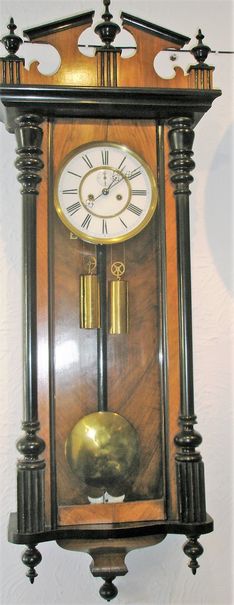Vienna Regulator Maintenance
Setting Up Vienna Regulator
Hang the case securely on a screw and if possible get an assistant to hold the case. With the shiny side of the pendulum facing you, hook the pendulum carefully onto the top suspension spring. Take the movement on its base platform and unravel the lines. Slide the movement into the bracket and guide the crutch pin into the pendulum's slot. Put in the side bolts loosely and close the door to check the dial is clearing the glass. Open the door and if correct tighten the side bolts. Check the crutch pin is clear of the back of the case and that the pendulum is not laying against the crutch arm. With a striking clock lift the hammer and release to check that it strikes the gong properly and sounds clear. If the sound id flat, bend it closer. Also check the hammer does not foul the back of the case or the pendulum.
Guide one of the lines down straightening any twists or kinks keeping it taut all the time. If the line is slightly long, hold the pulley and wind sufficiently to raise the pulley away from the bottom of the case before hooking the weight onto it.
With the clock veritcal, check that the back of the pendulum clears the case and weights are not touching glass. If either are touching then the case will have to be packed out at the top or the bottom to correct. Usually there are steady plates at the bottom of the case with screws which not only can be used for steadying but also for backward and forwards adjustment.
Now listen to the "tick". This must sound even in order that the clock functions correctly. If it is not, there is an adjustment for putting in beat on the side of the crutch. One or two knurled nuts are on the edges of the crutch which can be turned one way or the other to improve the tick until it is exact. Try turning a couple of times and decide if you are going the right or wrong direction by listening to see if the tick has been improved or made worse.
Winding Vienna Regulators
Usually once a week in a clockwise direction. Look carefully at the top of the line to make sure the pulley does not come off by overriding one of the knots fastening the line to the hook on the base of the platform. Wind both sides on a striking clock.
Hand Setting on Vienna Regulators
The minute hand should be moved forwards allowing the clock to complete its striking in each half hour and hour. For minor adjustments in a backwards direction move the minute hand only, between the figures IIII-I or X-VI if a striking clock.
Regulation of Vienna Regulators
This is done by the nut on the bottom of the pendulum. Often at the pendulum bob is a collar with a V notch in it, make sure the bob is always sitting correctly in the notch. If there are two nuts under this, then one is used to tighten the bottom nut against it. Turn the nut to the right (clockwise) to go faster and to the left (anti clockwise) to go slower. The shorter a pendulum is the faster the clock goes. To slow a clock down, make the pendulum longer by adjusting the 'rating' nut below the pendulum.
City Clocks Maintenance
At City Clocks we will be happy to advise you on your Vienna Regulator clock maintenance.
Contact us here or call us on 0800 78 345 87.
← Back to Clock Maintenance


